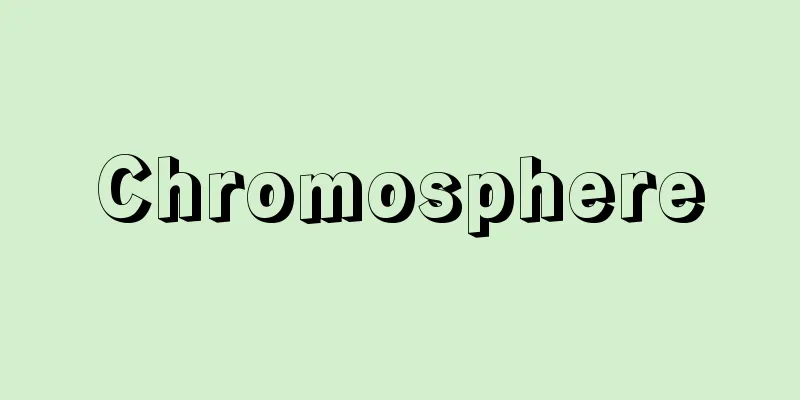Liquid crystal

|
A substance that exhibits the fluidity of a liquid, but at the same time, its physical properties (especially optical and electrical properties) are anisotropic like those of a crystal. Also called an anisotropic liquid, this state is intermediate between solid and liquid, or liquid and solid. [Toshihisa Yoshida] historyIn 1888, Austrian botanist Friedrich Reinitzer (1857-1927) discovered that cholesteryl benzoate melted at 145.5°C and turned into a cloudy liquid, and when the temperature was further increased, it turned into a clear liquid at 178.5°C. In 1889, German physicist Otto Lehmann (1855-1922) observed this cloudy liquid with a polarizing microscope and confirmed that it had properties such as birefringence (optical anisotropy), and named this state liquid crystal. Daniel Vorländer (1867-1941), a German chemist, contributed greatly to liquid crystal research, synthesizing many liquid crystal substances. By around 1920, more than 250 types were known. In terms of phenomenology, many of the results that are known today had been accumulated by around 1930, but there was no progress in theory or applications, and liquid crystal research began to decline. In 1950, Elliot A. Elliot and EJ Ambrose of the UK reported that concentrated solutions of synthetic polypeptides have a spontaneous orientation (liquid crystal structures formed when linear or plate-like liquid crystal molecules preferentially align in a specific direction), i.e. become liquid crystals, and liquid crystals began to attract attention in relation to biological tissues and functions. In 1963, James L. Fergason (1934- ) of Westinghouse Electric Company invented thermography (a method of measuring the temperature of an object's surface by a change in color) using liquid crystals, and in 1968, George H. Heilmeier (1936- ) of RCA Electric Company in the US discovered that liquid crystals become cloudy in an electric field, and research into their application to various display devices, wall-mounted televisions, etc. became active again. As of the year 2000, more than 10,000 types of liquid crystal substances are known. [Toshihisa Yoshida] ClassificationLiquid crystals are found in substances with linear or plate-like molecular structures, and are classified according to the way the molecules are oriented. In 1922, Georges Friedel (1865-1933) of France classified liquid crystal structures based on optical observations into three types: smectic, nematic, and cholesteric. In the smectic state, long, rod-like molecules are arranged with their long axes all parallel to form plates, and these plates are layered in the direction of their long axes. The name smectic comes from the Greek word smectos, meaning "soap-like," because this type of liquid crystal commonly shows the polarizing microscope image characteristic of a concentrated aqueous solution of soap (e.g., ammonium oleate). In the nematic state, long, rod-like molecules are arranged randomly with their long axes in a fixed direction, and are not in an orderly layered state. Therefore, X-ray diffraction only shows a blurred image. The word nematic comes from the Greek word nematos, meaning "thread-like" (e.g., p (para)-azoxyanisole). Furthermore, the cholesteric state has a layered structure like the smectic state, but the arrangement of the molecules in each layer is similar to that of the nematic state. Each molecular layer is extremely thin, the molecules within the layer are arranged along their long axis, and the planes of the layers are parallel. Furthermore, the long axis direction of the molecules in each layer is slightly offset from that of the molecules in the adjacent layers, resulting in a helical structure overall. This name comes from the fact that it is often seen in cholesterol derivatives (e.g., cholesteryl benzoate), but cholesterol itself does not have liquid crystal properties. Liquid crystals can also be classified according to the conditions under which they are formed. Liquid crystals that are formed by heating and melting a pure substance, i.e., by heat, are called thermotropic liquid crystals, while liquid crystals that are formed by adding a solvent to an organic substance to change the concentration of the solute are called lyotropic liquid crystals, named after the Greek word for solvent, lyo. Cholesteryl benzoate is an example of the former, while concentrated aqueous solutions of soaps are a typical example of the latter. [Toshihisa Yoshida] Molecular structureThe molecular structures of substances that can become liquid crystals are generally thought to be as follows. First, the geometric shape of the molecule must be elongated and rod-like or flat. Second, it is necessary to have an appropriate amount of intermolecular force to maintain the parallel arrangement of the molecules. Therefore, it is desirable to have elongated molecules that have functional groups with permanent dipoles or bonds that are easily polarized. As a specific example, consider trans pn-alkoxycinnamic acid. Since it is a trans and para isomer, it is close to linear, and when it forms a dimer (two molecules that join together and behave as if they were one molecule) through hydrogen bonding at the carboxyl group (carboxyl group) -COOH, it becomes even more linear. Furthermore, since the molecule contains a benzene ring, an alkoxy group RO- with a dipole, a carbonyl group =O that is easily polarized, and a carbon-carbon double bond =, it has an appropriate amount of intermolecular force. On the other hand, the cis isomer is not linear, so it cannot become a liquid crystal. [Toshihisa Yoshida] Observation of Liquid Crystals, Their Properties and ApplicationsThe formation of liquid crystals can be experimentally confirmed by observing them under a polarizing microscope. A sample is sandwiched between a slide and a cover glass to form a thin layer, heated until it becomes an isotropic liquid, and then observed as it cools. The field of view, initially dark, between crossed Nicols (two Nicol prisms that only transmit a certain plane polarized light, arranged perpendicular to the polarization plane), soon begins to show shiny particles and patterns as liquid crystals are formed. These are patterns called textures that characterize the three liquid crystal states. The results of basic research into liquid crystals are relatively easy to apply. Here, we will not discuss "liquid crystal displays," which have by far the most applications, as this is covered in a separate article. In smectic systems, this pattern is characteristic of the thick soapy aqueous solution mentioned above. Observation of a thin layer between glass plates reveals that it is liquid in two-dimensional directions within the glass surface, but has no mobility in the one-dimensional direction perpendicular to this. It appears to be a greasy, sticky, and murky fluid. Its viscosity changes when an electric field is applied, and this change is tens to hundreds of times larger, making it highly responsive, so it is used as a damper in brakes, clutches, etc. It is also attracting attention as a lubricant for use in controlling friction by changing its properties in response to external fields (light, electric field, heat, pressure, etc.). In nematic systems, it is a thread-like pattern, and a cloudy fluid with enough fluidity to form a meniscus in a capillary (a curved surface of the liquid in the capillary relative to the gas phase). The most notable characteristic of nematic liquid crystals is that, under the influence of a magnetic field, electric field, surface force, or mechanical force, the anisotropic molecular groupings tend to align irregularly, causing fluctuations in the refractive index and resulting in opacity. Naturally, it becomes transparent when the influence disappears. This has led to applications such as window glass, which can be used as transparent glass or frosted glass at will. Cholesteric liquid crystals have a structure similar to that of smectic liquid crystals. As a concrete example, a molten liquid of a cholesteric benzoic acid ester is cooled. Just before solidifying, a unique and beautiful rainbow glow is observed. It first glows a vivid emerald green, then changes to blue-green, dark blue, yellow-green, yellow, orange-red, and finally becomes bright red, before finally cooling and solidifying, becoming colorless. This is because cholesteric liquid crystals are optically active substances, have a large optical rotation, and cause circularly polarized light reflection in a specific wavelength range. The interference colors of these thin layers change sensitively with temperature, mechanical misalignment, electric fields, and the adsorption of organic vapors. Of these, the temperature effect is used in thermometers and thermography. All of these liquid crystals can be obtained by changing the temperature, such as by heating or cooling, and are called thermotropic liquid crystals. On the other hand, in some substances, the liquid crystal state can be generated by changing the concentration of the solute. This is called lyotropic liquid crystals. In lyotropic liquid crystals, the formation of liquid crystals can be confirmed by measuring the relationship between concentration and viscosity. This is because a unique phenomenon is observed in which the viscosity decreases as the concentration increases beyond the concentration at which liquid crystals begin to form. If the sudden drop in viscosity at this time is used to spin polymer liquid crystals, strong fibers with good molecular orientation can be obtained. In other words, this is polymer liquid crystal spinning. Some of these fibers are dozens of times stronger than nylon and aramid fibers (such as DuPont's Kevlar), and PBO fibers (fibers made by spinning polyparaphenylene benzobisoxazole from liquid crystals, jointly developed by Toyobo and Dow Chemical; trademark name: Zylon), which are stronger than carbon and steel fibers, have also been put to practical use. In addition to the thermal properties of liquid crystals, the color change of cholesteric liquid crystals due to gas absorption and photoelectromotive force are also used in detectors. There are also sensors that respond to pressure, electricity, radiation, ultraviolet rays, infrared rays, etc. In addition to thermometers, temperature measurement using liquid crystals is mainly used for non-destructive testing of structures and electronic components. It is also used to measure temperature in living organisms, for example to identify the location of tumors and cancers. The property of cholesteric liquid crystals, in which the color they show changes sensitively in response to the adsorption of very small amounts of chemical substances, is used in gas detectors, etc. It has also been reported that they can be used as optical elements in optical switches for fiber communication. Although liquid crystals have the drawback of a slow response speed, they have the great advantage of low voltage operation and low power consumption. Liquid crystals are also used in spectroscopic studies that utilize the orientation of liquid crystal molecules in electric or magnetic fields, and as anisotropic solvents in chemical reactions. In analytical chemistry, there are gas chromatography, supercritical fluid chromatography, and high performance liquid chromatography using liquid crystal stationary phases, which mainly separate the molecules by their shape. Furthermore, the absolute configuration of the liquid crystal structure can be determined by the circular dichroism spectrum induced by adding a trace amount of optically active compound to a nematic liquid crystal. Naturally, liquid crystals also provide useful information for determining molecular structure as an orienting solvent for nuclear magnetic resonance (NMR), electron, and infrared spectroscopy. On the other hand, there have been many studies on using liquid crystals as anisotropic solvents in chemical reactions, where the orientation is reflected in the solute molecules. [Toshihisa Yoshida] "Liquid Crystals" by Tachibana Taro et al. (1972, Kyoritsu Shuppan)" ▽ "The Latest Technology of Liquid Crystals" by Matsumoto Shoichi and Kakuta Ichiro (1983, Kogyo Chosakai)" ▽ "Liquid Crystal Materials" edited by Kusabayashi Shigekazu (1991, Kodansha)" ▽ "Chemistry of Liquid Crystals" edited by the Chemical Society of Japan (1994, Academic Press Center) " ▽ "Physics of Liquid Crystals" by S. Chandrasekhar, translated by Kimura Hatsuo and Yamashita Mamoru (1995, Yoshioka Shoten)" ▽ "An Easy-to-Understand Explanation of Liquid Crystals" by Nanohiko (1998, Nihon Jitsugyo Shuppan)" ▽ "Liquid Crystal Handbook" edited by the Liquid Crystal Handbook Editorial Committee (2000, Maruzen)" ▽ "The Book of Understanding Liquid Crystals -- Q&A File 101" by Naemura Shohei (2001, Kogyo Chosakai) [References] | | | | | | | | | | | | | | | | | | | | | | | | | | | |©Shogakukan "> Classification of Liquid Crystal Structures ©Shogakukan "> Structure of trans pn-alkoxycinnamic acid Source: Shogakukan Encyclopedia Nipponica About Encyclopedia Nipponica Information | Legend |
|
液体としての流動性を示すと同時に、物理的性質(とくに光学的、電気的)は結晶と同じく異方性を示す状態にある物質。異方性液体ともいい、固体から液体、または液体から固体になる中間においてこの状態を示す。 [吉田俊久] 歴史1888年、オーストリアの植物学者レーニッツァーFriedrich Reinitzer(1857―1927)が、安息香酸コレステリルを熱すると145.5℃で溶けて濁った液体になり、さらに温度を上げると、178.5℃で透明な液体になることを発見した。1889年にドイツの物理学者レーマンOtto Lehmann(1855―1922)は、この濁った液体を偏光顕微鏡で観察して複屈折する性質(光学的異方性)などがあることを確認し、この状態を液晶と名づけた。液晶研究に化学の面から寄与したのはドイツのホルランダーDaniel Vorländer(1867―1941)で、多数の液晶物質を合成した。1920年ごろまでには約250種以上が知られるようになっていた。現象論の面で、今日、明らかになっている多くの成果は1930年ごろまでには蓄積されていたが、理論、応用面での発展がなく、液晶研究も下火になっていった。 1950年、イギリスのエリオットA. ElliotとアンブローズE. J. Ambroseは、合成ポリペプチドの濃厚溶液が自発的な配向(線状あるいは板状構造をもつ液晶分子がある特定の方向に優先的に配列して結晶的構造を形成すること)構造をもつこと、すなわち液晶になることを報告し、液晶が生体の組織、機能の関連において注目され始めた。1963年にアメリカ、ウェスティングハウス社のファーガソンJames L. Fergason(1934― )が液晶を用いたサーモグラフィ(物体表面の温度を色の変化で測定する方法)を考案し、さらに1968年にアメリカ、RCA社のヘイルマイヤーGeorge H. Heilmeier(1936― )は、電場の中で液晶が白濁するのを発見し、種々の表示装置(ディスプレー)、壁掛けテレビなどに応用する研究もふたたび盛んになってきた。2000年時点で、液晶物質としては1万種以上のものが知られている。 [吉田俊久] 分類液晶は線状か板状の分子構造をもつ物質においてみられ、分子の配向の仕方によって分類される。1922年フランスのフリーデルGeorges Friedel(1865―1933)は、光学的観察に基づく液晶構造について、スメクチック、ネマチック、コレステリック状態の三つのタイプに分類した。スメクチック状態とは、細長い棒状の分子がその長軸をすべて平行に配列して板状になり、この板が長軸の方向に幾重にも重なり合って層状となったものである。スメクチックsmecticの名称はギリシア語で「せっけん状」を意味するsmectosに由来し、このタイプの液晶がせっけんの濃厚水溶液に特有な偏光顕微鏡像を共通に示すことによっている(オレイン酸アンモニウムなど)。ネマチック状態は、細長い棒状の分子が長軸を一定の方向にして不規則に配列した状態で、整然とした層状にはなっていない。したがって、X線回折によってもぼやけた像を示すにすぎない。ネマチックnematicは「糸状」という意味のギリシア語nematosからつくられた(p(パラ)-アゾキシアニソールなど)。さらにコレステリック状態は、スメクチック状態と同様に層状構造をもつが、各層における分子の配列はネマチック状態に似ている。各分子層はきわめて薄く、層内での分子の配列は長軸方向で、層の面は平行である。しかも各層内の分子の長軸方向は隣接する層の分子のそれとわずかにずれて、全体として螺旋(らせん)構造をとっている。コレステロール誘導体に多くみられるのでこの名がついているが(たとえば安息香酸コレステリルなど)、コレステロール自身には液晶性はない。 液晶の生成条件によっても分類できる。純粋物質の加熱融解、すなわち熱によって生ずるものをサーモトロピック液晶thermotropic liquid crystalとよび、ある有機物質に溶媒を加えて溶質の濃度を変えることによりできるものを、溶媒のギリシア語lyoにちなんでリオトロピック液晶lyotropic liquid crystalとよんでいる。安息香酸コレステリルなどは前者の例であり、せっけん類の濃厚水溶液は後者の代表例である。 [吉田俊久] 分子の構造どのような分子構造をもつ物質が液晶になりうるか、一般には次のように考えられている。 まず、分子の幾何学的な形状が細長い棒状または平板状であること。次に、分子の平行配列を保持するため、適当な大きさの分子間力をもつことが必要である。したがって永久双極子をもつ官能基や分極されやすい結合などを分子内にもつ細長い分子が望ましいといえる。具体例として、トランスp-n-アルコキシケイ皮酸を考える。トランスそしてパラ体であるから直線状に近く、カルボキシ基(カルボキシル基)-COOHの部分で水素結合し、二量体(二つの分子が会合して、あたかも一つの分子としてふるまうもの)化してさらに直線性が増す。しかも分子内に、ベンゼン環や、双極子をもつアルコキシ基RO-、分極しやすいカルボニル基=Oや炭素‐炭素二重結合=があるから、適度の分子間力をもつことになる。他方、異性体としてのシス体は直線状でないから液晶にはなりえない。 [吉田俊久] 液晶の観察、その性質と応用液晶の生成を実験的に確認するには偏光顕微鏡で観察するとよい。試料をスライドとカバーガラスに挟んで薄層にして、等方性液体にまで加熱したあと冷却しながら観察する。直交ニコル(ある平面偏光のみを通すニコル・プリズム2個を偏光面に対して垂直に並べたもの)の間で初め暗黒だった視野に、やがて液晶の生成と同時に、光った粒子や模様が現れる。これは三つの液晶状態を特徴づける組織(texture)という模様である。液晶は基礎研究の成果が比較的容易に応用に結び付く。ここでは、圧倒的に応用の多い「液晶ディスプレー」については別項に取り上げてあるので省略する。 スメクチック系では、前述の濃厚なせっけん水溶液特有の模様である。ガラス板間の薄層の観察から、ガラス面に対しては面内の二次元方向には液体であるが、これと垂直な一次元方向には運動性がないこともわかる。外見をみてもグリース状で粘着性の強い濁った流体である。電場を加えたときに粘度が変化するが、その変化が数十倍から数百倍と大きく応答性がよいことから、減衰器としてブレーキ、クラッチなどに使われる。また、潤滑剤として外部場(光、電場、熱、圧力など)による特性の変化を用いた摩擦の制御への利用も注目されている。 ネマチック系では糸状の模様であり、毛管中でメニスカス(毛管内の液体が気相に対して曲面になることをいう)をつくるほど流動性のある濁った流体である。ネマチック液晶のもっとも大きな特徴は、磁場、電場、表面力あるいは機械力の影響で、異方性の分子集団が不規則に配列し、屈折率に揺らぎがおこり白濁を生ずる傾向があることである。当然、影響力が消えると透明になる。これは思いのままに透明ガラス、曇りガラスとして利用できる窓ガラスなどへの応用が実現している。 コレステリック液晶はスメクチック液晶に似た組織を示す。具体例として、コレステリック系の安息香酸エステルの融解液を冷却する。固化直前に独特の美しい虹(にじ)色の輝きがみられる。まず鮮やかなエメラルドグリーンに輝きだし、ついで青緑、濃紺、黄緑、黄、橙赤(とうせき)と移って、さらには真っ赤になり、やがて冷却固化して無色になる。これは、コレステリック液晶が光学活性物質であり、大きな旋光性をもち、特定波長領域で円偏光反射をおこすからである。これらの薄層の干渉色は、温度、機械的なずれ、電場、有機蒸気の吸着などで鋭敏に変化する。このうち温度効果が温度計そしてサーモグラフィなどに応用されている。 これらの液晶はいずれも加熱あるいは冷却という温度変化により得られるもので、サーモトロピック液晶とよばれる。一方、ある種の物質では溶質の濃度の変化によって、液晶状態を生成させることができる。それをリオトロピック液晶という。 リオトロピック液晶では濃度‐粘度の関係を測定すると、液晶の生成が確認できる。液晶の生成し始める濃度を境に、濃度が増せば粘度が低下する特有の現象がみられるからである。このときの急激な粘度の低下を利用して高分子の液晶を紡糸すると、分子の配向のよい強靭(きょうじん)な繊維が得られる。すなわち高分子液晶の紡糸である。これらの繊維にはナイロン、アラミド繊維(デュポン社の「ケブラー」など)よりも数十倍も強いものがあり、炭素繊維やスチール繊維より強度で凌駕(りょうが)するPBO繊維(東洋紡績とダウ・ケミカル共同開発の、ポリパラフェニレンベンゾビスオキサゾールを液晶紡糸した繊維。商標名「ザイロン」)なども実用化されている。 液晶の熱的性質のほかに、ガス吸収によるコレステリック液晶の色の変化、光起電力なども検知器に利用されている。圧力、電気、放射線、紫外線、赤外線などに応答するセンサーもある。液晶による温度測定は温度計以外に、主として構造物、電子部品などの非破壊的検査に応用されている。生体における温度測定、たとえば腫瘍(しゅよう)や癌(がん)の部位を知るためにも利用されている。コレステリック液晶の示す色がごく微量の化学物質の吸着によって敏感に変化する性質は、ガス検知器などに利用されている。また、光学素子としてファイバー通信用光スイッチなどにも応用できるとの報告もある。液晶は応答速度が遅いという難点があるにもかかわらず、低電圧駆動、低消費電力という利点に大きな特徴をもっている。 電場あるいは磁場による液晶分子の配向性を利用した分光学的研究や、化学反応への異方性溶媒としての液晶の利用もある。分析化学面では、おもに分子の形の違いを分離要因とする液晶固定相のガスクロマトグラフィー、超臨界流体クロマトグラフィーや高速液体クロマトグラフィーがある。さらに極微量の光学活性化合物をネマチック液晶に加えて誘起させる円二色性スペクトルにより液晶構造の絶対配置の決定ができる。当然、核磁気共鳴(NMR)、電子そして赤外スペクトル測定用の配向性溶媒としても、分子構造の決定に有力な情報を提供してくれる。一方、化学反応で、液晶を異方性溶媒としてその配向性を溶質分子に反映させて化学反応を行うことも、数多く検討されている。 [吉田俊久] 『立花太郎ほか著『液晶』(1972・共立出版)』▽『松本正一・角田市良著『液晶の最新技術』(1983・工業調査会)』▽『艸林成和編『液晶材料』(1991・講談社)』▽『日本化学会編『液晶の化学』(1994・学会出版センター)』▽『S・チャンドラセカール著、木村初男・山下護訳『液晶の物理学』(1995・吉岡書店)』▽『那野比古著『わかりやすい液晶のはなし』(1998・日本実業出版社)』▽『液晶便覧編集委員会編『液晶便覧』(2000・丸善)』▽『苗村省平著『液晶がわかる本――Q&Aファイル101』(2001・工業調査会)』 [参照項目] | | | | | | | | | | | | | | | | | | | | | | | | | | | |©Shogakukan"> 液晶構造の分類 ©Shogakukan"> トランスp-n-アルコキシケイ皮酸の構… 出典 小学館 日本大百科全書(ニッポニカ)日本大百科全書(ニッポニカ)について 情報 | 凡例 |
>>: fortune teller - fortune teller
Recommend
San Joaquin River
A river in central California, USA. It flows south...
Harumi Shibukawa
Year of death: 6th October 1715 (1st November 1715...
Nonomiya
[1] 〘Noun〙① The purification place of the Saio (Sa...
Shimazu Yoshihiro
A military commander from the Sengoku period to t...
Enharmonic pronunciation - Imeidōon
→Enharmonic Source : Heibonsha Encyclopedia About ...
Oshimada - Oshimada
〘Noun〙 A large Shimada topknot. ※Ukiyo-zoshi , Amo...
Adirondack Rocks - Adirondack Rocks
...As a result of the Apollo lunar exploration, i...
Empress Wu Zetian
She was the empress of Emperor Gaozong, the third...
Ushinbo - Ushinbo
...It has many local names throughout the country...
Bucculatrigidae
...The feeding scars vary from species to species...
Blue-faced booby - Blue-faced booby
...The species that build nests on the island by ...
Halemaumau
...It is composed of lava flows of tholeiitic oli...
sweet lime
…Several lime species have been reintroduced in r...
polyud'e (English spelling) polyude
… From the 9th to the mid-10th century, princes t...
Excess liquidity
A state in which the liquidity of cash, deposits, ...





![Kamikatsu [town] - Kamikatsu](/upload/images/67cb3ed2a5548.webp)



